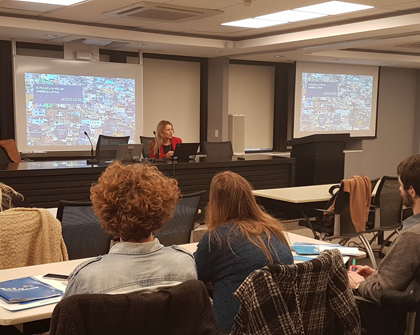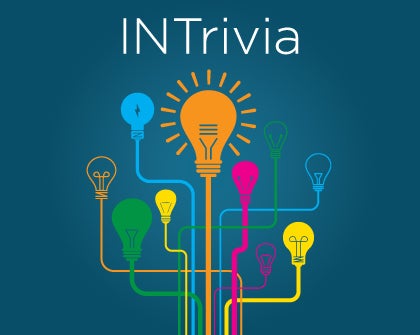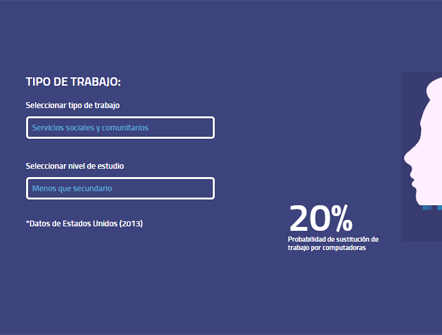On July 12, 2017, a new series of the “Inspire” talks took place, organized by INTAL/IDB and Argentina’s Ministry of Modernization. The focus of this series was on issues such as innovation, open government, new technologies, and transparency. The main topic of the event was “Public Innovation with a Focus on Sustainable Development,” and proceedings revolved around the 17 Sustainable Development Goals that the United Nations established in 2015 as a target for 2030.
The series of talks included presentations from Ana Basco, integration specialist at INTAL/IDB; Agustín Dellagiovanna, national director for the development of social responsibility and sustainability at the Ministry of Social Development; and Mario Roset, director of the NGO Wingu.
Ms. Basco began by presenting the results of the research that INTAL has been carrying out to compare objective indicators on the realities of life in Latin America that are connected to the SDGs (such as the environment and social circumstances) with the subjective views that citizens from the region and young people from Argentina have on these issues. To make these comparisons, Ms. Basco drew on three sources: the IDB publication “Social Pulse in Latin America and the Caribbean 2016: Realities & Perspectives,” which describes the region’s trends over the last 20 years through social indicators; the results of the INTAL/Latinobarómetro survey, which interviewed 20,000 people in 18 countries in the region; and the “Millennial Beats” study, a joint project between INTAL and the Voices! consultancy firm that surveyed 600 young people from Argentina on their values, expectations, and consumer habits.
“The last 20 years have brought major social advances in Latin America: poverty has decreased and the middle class has grown. Some 96% of homes now have access to reliable drinking water, infant mortality has also come down by 65%, and 98% of children have access to primary education. Women now account for a greater share of family income and the habitability of homes has risen. Yet despite these advances, Latin America remains the most unequal region in the world. Approximately 60% of employment is informal and 37% of homes are vulnerable (with incomes that range between US$5 and US$12), the number of female-headed single-parent homes has increased, and 15% of young people are not in education or employment. There are many differences in older adults’ access to pensions: only 13% of those at the lower end of the socioeconomic spectrum have pensions, while as many as 73% of middle-class adults do,” Ms. Basco said. “This comes in a macroeconomic context of recession, as there has been a downturn in growth over the last few years. There are fiscal deficits in every country in the region and a drop in trade, although it has picked up slightly in the last few months. Latin America has entered a risk zone: we run the risk of poverty increasing again and inequality continuing to rise.”
Given this combination of progress and setbacks, INTAL decided to find out more about what Latin Americans think about development-related issues. “The issues that people are most concerned about are social inclusion, the environment, and equal opportunities, which are all key to achieving the SDGs. There is a certain awareness among the region’s citizens that these issues are a critical part of development.”
According to the INTAL/Latinobarómetro survey, 49% of Latin American citizens would be willing to pay 20% more for a product which had been produced in an environmentally friendly way, while 46% would also be willing to pay a similar premium for a product that guaranteed that workers’ rights had been respected. “We interpret this number as being high because it implies a drop in people’s spending power if they are willing to pay more for these products. There is agreement among citizens on the importance of the environment and social issues.”
What do millennials think about development-related issues? According to the survey that INTAL and Voices! carried out among young Argentinians between the ages of 18 and 34, 38% of them are in favor of allowing immigrants into their countries provided that there is work available. “Citizens are aware of the employment issue, which is key to achieving the SDGs,” Ms. Basco said. Young people have a similar position when they are asked about free trade. “We asked them, on a scale of 1 to 10, how in favor they were of free trade. Some 41% of millennials took a more protectionist stance, which shows that they are aware of the effects of trade unemployment and wish to safeguard local aspects.”
The survey also looked at innovation and young people’s vision of the future. “Latin American citizens think that health, environmental protection, and job creation are the areas that innovation will have the greatest impact on. We asked Argentinian millennials the same question and they gave similar answers, but also added education.” Ms. Basco argued that “we believe that the development agenda is in sync with current social issues and the views of Latin Americans and Argentinian millennials. This is a very important step toward achieving the SDGs.”
Agustín Dellagiovanna then reminded the audience that the UN SDGs seek to “end poverty and stabilize the environment while also guaranteeing peace and prosperity for all the world’s communities. One interesting aspect of the goals is that they are for states, companies, and civil society organizations. This shift implies that, for the first time ever, we need to work together to achieve these objectives, not as individual players. The SDGs have put social responsibility back on the agenda and expanded the concept to include sustainability and sustainable development. The state needs to guarantee that the SDGs are met, and they need to do so in a world in which business has changed and the consumer is playing a totally different role and beginning to demand that the private sector complies with certain parameters. These days, any firm that is not responsible for the impact it generates in the community is seen as a negative force.”
“This government has set itself the target of zero poverty, and we are hard at work on that,” Mr. Dellagiovanna said. He argued that they were generating partnerships to work on the 17 SDGs. “Historically, the private sector has found it hard to work together with the state, especially on public policies related to poverty. So we’re trying to develop tools to respond to that demand, to gain the trust of the private sector and NGOs so that we can work together more effectively. The first of these tools is the Social Responsibility Forum for Sustainable Development, which minister for social development Carolina Stanley launched in mid-2016. This forum is a space for different stakeholders (private companies, NGOs, and the government) to work together innovatively and creatively. It is not just another workspace, but includes timeframes, processes, and methodologies to enable us to identify small projects all over the country where we can replicate other initiatives that are being developed, and to do so within 100 days.”
Based on this work, “we have found many civil society organizations that are working on the same things in the same place—they need to get together, work together, find out where they are falling short and what they’re doing right,” Mr. Dellagiovanna said. He also argued that companies “should spend their money where they make an impact. Our goal is to create a network in each province to bring these players together so that they can get to know each other and develop projects together.”
Mario Roset, the director of Wingu, an NGO that has spent the last nine years working to use technology and innovation to strengthen other NGOs, commented on the way that civil society organizations are adopting information technology based on data from a survey of 400 organization set is carried out every year. “In terms of communications, these companies work with social networks, traditional websites, Facebook, Twitter, and instigate. Many use email marketing as their main tool for reaching people. Only 20% of respondents use technology to develop their funds.”
However, Wingu’s survey found that 21% of organizations from civil society keep their information, which is often sensitive, on paper. “As NGOs, we have the advantage of being able to access free tools that are provided by private firms,” Mr. Roset said. The challenge is converting that into more volunteers, more donors, or better results for target populations. However, recent years have brought developments in the way that NGOs use technology. For example, many now have top-of-the-line management systems for handling data and engaging in digital marketing campaigns. These sorts of systems are available to NGOs at a very low cost.”
Mr. Roset then mentioned several collaborative, open-data projects from the third sector, such as “Cuida tu escuela (in Mexico), “Caminos de la villa” (Buenos Aires), and “Float Beijing” (China). He also discussed the main lessons that Wingu had learned from the projects it had implemented. “Right from day one, you need to keep the user or recipient in mind when designing this type of platform. Giving and asking for feedback all the time is essential. Users must be a part of the process.” He also admitted that “we shouldn’t reinvent the wheel—it is important to learn from other existing platforms and then build on them.” He finished his presentation by suggesting that organizations need to “open up the playing field and share things” to better develop these processes. “We need to seek out allies from the get-go and surround ourselves with good people.”







